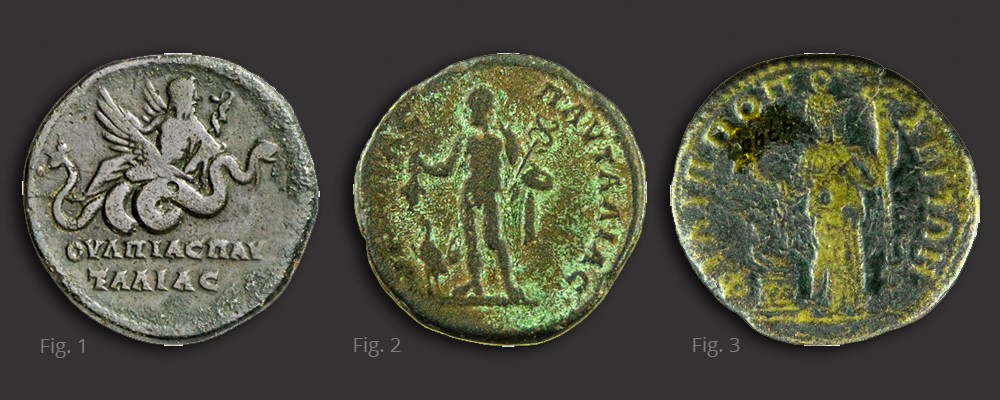The focus of this numismatic research project was the comparative analysis of the coinage of two Thracian poleis, both of which minted coins under Roman rule. The first polis is Philippopolis (modern Plovdiv), located in central Thrace, and the seat of the Thracian Koinon; the other is the western Thracian polis Pautalia (modern Kjustendil), whose warm healing springs had provided the city with high supra-regional prestige already in antiquity.
Research

Fig. 1 Bronze coin of Pautalia struck under Septimius Severus with Asklepios on winged serpent on reverse © Lutz-Jürgen Lübke | Fig. 2 Bronze coin of Pautalia struck under Caracalla with Hermes on reverse (fig.2) © Lily Grozdanova | Fig. 3 Bronze coin of Philippopolis struck under Septimius Severus with Demeter on reverse (fig.3) © Lily Grozdanova
Data collections
The coins of Philippopolis and Pautalia have been studied as an efficient medium of recording and disseminating messages. It was necessary to collect all relevant coins from public and private collections all over the world as well as those published in modern literature and auction catalogues. This has been a time-consuming task, because both poleis minted a relatively big amount of coins, but there have been collected more than 2.000 specimens of Pautalia and over 4.000 of Philippopolis. All coins have been photographed and the process of including them into the online web-portal of ancient Thracian coins was initiated. Through this portal, the research of the project B-4-2 was embedded in a broader international frame: the online portal of Greek coin types and the type catalogue of Roman Provincial Coinage.
Analysis and Results
Besides collecting the coins their analysis was started, the coin types and the denomination system were interpreted. In particular, in the Antonine and Severan periods the minting activity of the cities was characterized by its high output and the rich variety of types, many of which showed references to local peculiarities: unusual landscape features, regional resources, economic conditions, cultural and religious customs, athletic contests, local myths, indigenous deities (fig. 1), privileges granted by the Roman authorities, acclamations, etc. In sum, these coins are a very important evidence for the highly complex interplay between local polis identities and the belonging to the Roman Empire.
To give some details: Remarkable similarities in the design and the style of dies issued by Philippopolis and Pautalia could be identified. Both cities – together with other poleis in inner Thrace – belonged to a common workshop. The hoard analysis showed that special specimens produced in a common atelier (in Philippopolis?) circulated in the entire delivery territory (“Lieferbezirk”). Furthermore, several type variations (for example a rooster appearing in front of a standing Hermes holding a purse and caduceus (fig. 2) or a specific type of Demeter with serpent-entwined torch and cista mystica in front of her (fig. 3) indicate regional peculiarities, with noteworthy parallels between Philippopolis and Pautalia.
Activities
One of the highlights of the activities of project B-4-2 was a huge international Congress entitled “Thrace – Local Coinage and Regional Identity. Numismatic Research in the Digital Age” held in 2015. The possibilities of discovering a specific Thracian identity in the various local Thracian coinages were discussed during this conference. A further topic was the question of how the social, economic and administrative conditions could evoke transformations of identity constructions.
The second noteworthy event was the exhibition “Thrace 3.0: Coinage in the Land of Orpheus”. It was co-created by the BBAW’s DFG-project and the Münzkabinett and was presented for one year in the Bodemusem. The exhibition included special showcases with coins of Philippopolis and Pautalia with instructive expressions of local identities.
Furthermore, the project staff had the opportunity to publish several papers and to present their results not only at Topoi events, but also at many other scientific forums, for instance at the XV International Numismatic Congress at Taormina (Sicily).
ReLated Links
- The Ancient Coins of Thrace/Corpus Nummorum Thracorum: www.corpus-nummorum.eu
- Online Greek Coinage: http://www.greekcoinage.org/
- Roman Provincial Coinage Online: http://rpc.ashmus.ox.ac.uk
